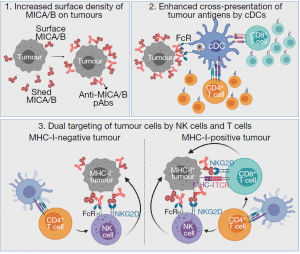Tumours are known to have various mechanisms in place that allow them to continuously evade the immune system. Ideally one of the best ways to counteract this and give the immune system a fighting chance would be to develop therapeutic interventions that can easily boost the immune response to cancer , if not, directly overcome the mechanisms that are responsible for promoting tumour growth.
Badrinath and colleagues report of a vaccine designed to target one tumour immune escape mechanism. Another aspect that makes this vaccine unique is its ability to elicit responses from both T cells and NK cells, as demonstrated in Figure 1.
The targets of this vaccine, MICA and MICB (MICA/B), are stress proteins that are upregulated as a result of DNA damage in several cancers but are known to be expressed in very low levels in healthy cells. Specifically, the vaccine targets a highly conserved α3 domain in MICA/B, which is also a site of proteolytic shedding.
Proteolytic shedding of MICA/B from the surface of cancerous cells is how tumours are able to block the cytotoxic activity of natural killer (NK) cells and CD8+ T cells. This immune response can only be elicited as a result of the NKG2D receptor engaging with MICA/B bound to the surface of tumour cells.
The safety and immunogenicity of this vaccine was tested in non-human primates, specifically four rhesus macaques that endogenously express MICA/B proteins. After immunization, anti-MICA and anti-MICB antibodies were detected in all four macaques. Booster vaccinations were seen to increase the production and detection of these antibodies up to 1,000 fold. Changes in the blood chemistry of these animals were examined to determine if there were any clinical side-effects as a result of immunization and none were detected. The authors concluded that this does give preliminary evidence of the vaccine’s safety.
The authors went further to look at the recruitment of T cells and NK cells, the mechanisms used by CD4+ T cells to recruit NK cells and whether the vaccine can provide immunity against resistant tumours.
Overall, what we know now about this vaccine is that the antibodies generated do inhibit proteolytic MICA/B shedding by tumour cells thereby enhancing the cytotoxic activity of both NK cells and CD8 T-cells. This vaccine was also able to elicit CD4+ T-cells. This is what the authors had to say as a result of this; “Engagement of multiple effector cell populations enabled induction of protective immunity against tumours with common escape mechanisms, including loss of MHC-I expression or IFN-γ receptor signalling by tumour cells”.
From here, the authors believe the next step would be to carry out a clinical trial in human beings that have cancer. The authors would also like to see what this vaccine can do when used in combination with other strategies to treat cancer , such as local radiation therapy.
Journal article: Badrinath, S., et al., 2022. A vaccine targeting resistant tumours by dual T cell plus NK cell attack. Nature.
Summary by Vanessa Muwanga











